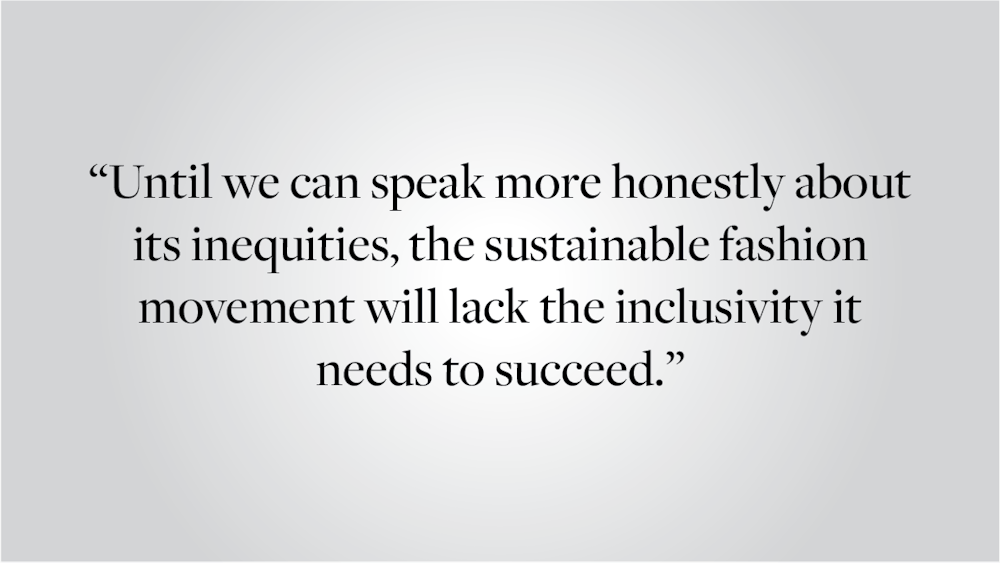There’s this dress I’ve been eyeing for a while now. Puff-sleeved and speckled with floral print, it’s classic, playful and exactly the kind of style the brand Reformation is known for. Founded in 2009, Reformation has become famous not only for its dresses but also for its commitment to reduce its impact on the planet with a “focus on climate action and environmental justice.” A 2019 Fashion@Brown article by Marley Presiado ’22 names the company, along with Everlane and Stella McCartney, as one of the brands gaining traction among consumers concerned with shopping sustainably. But sustainability often comes at a cost, one I can see glaring back at me from my online cart. The price tags on a mini dress or ethically-sourced sweater implicate class dynamics that often go ignored by advocates of eco-fashion. Purchasing environmentally conscious clothing and detaching from a wasteful, vicious cycle of fast fashion is often framed as a consumer’s responsibility and a moral achievement. But making these kinds of choices remains a luxury for many shoppers. Until we can speak more honestly about its inequities, the sustainable fashion movement will lack the inclusivity it needs to succeed.
The premise behind sustainable or slow fashion brands is that they aren’t just selling a product but an ethos as well. In an industry that produces 10% of the world’s carbon emissions and over 92 million tons of material waste annually, these are the brands that make a concerted effort to reduce water usage, recycle materials and cut emissions. Because of the added costs associated with a lower scale of production and the use of ethically-sourced materials, the biggest names in slow fashion are significantly more expensive than the fast fashion brands that have long defined the market — think Forever 21, H&M and Zara.
Fast fashion is wasteful beyond belief. Its models of constant production in many ways represent the very worst of the industry, and slowly but surely, these brands are falling out of favor. I’ve watched it happen in my own closet. Ask me where my pants are from, and I feel compelled to add an asterisk to contextualize my purchase in order to save face: They’re from Zara, but I bought them years ago. I would never shop there now.
And yet fast fashion’s promise of democratizing fashion and allowing the everyday shopper to access runway trends without breaking the bank is hard for me to totally disavow — especially when slow fashion retailers seem relatively unconcerned with capturing a similar spirit of accessibility. It would be one thing if there were brands serving customers who wanted to shop more sustainably at a range of price points. But practically all the labels taking ethical clothing mainstream are markedly more expensive than their fast fashion counterparts. That cost differential remains a significant barrier to more eco-friendly shopping habits for many, yet the nuances of class differences are still too often ignored in favor of moral grandstanding. Virgil Abloh, the lead designer behind luxury brand Off-White said back in 2016, “Don’t let Zara and Uniqlo educate you on the price of a garment because that’s not fashion. That’s McDonald’s.” Abloh’s comment treats fast fashion with the moral superiority of someone who drops hundreds of dollars on groceries for their new, vegan lifestyle and lectures their friends to do the same. It’s a privileged take on slow fashion that is worryingly pervasive, not only among upper-middle-class consumers, but also among the figures most influential in the industry.
Of course, buying new from high-end brands isn’t the only path to a more environmentally conscious wardrobe. Thrift and secondhand retail stores have existed for decades — purveyors of sustainable fashion before it was trendy, with the added benefit of being relatively affordable and accessible. Much like thrifted garments themselves, the secondhand apparel market has gained a new lease on life. Worth $28 billion in 2019, its value is now expected to reach $64 billion by 2024. However, because of this rapid growth, a gap is developing between consumers who thrift out of economic necessity and those who do so for the aesthetic. The “gentrification” of thrifting drives up store prices while buyers resell their finds on curated online marketplaces for double or triple the cost. Even in practices premised on accessibility, there are economic inequalities and incentives at play.
It’s easy to dismiss these worries, to discount any considerations that seem less consequential than the ultimate goal of protecting the environment. And yes, it’s crucial to reduce overconsumption and to make informed choices that trend toward sustainability. But it’s also necessary to be somewhat realistic and recognize that shopping will always hold cultural relevance. Especially for young people, experimentation and expression through fashion remain essential tools for self-identification. Being shut out of this cultural practice is yet another way that the stratification of wealth manifests itself.
It’s important to keep that in mind as we seek out new pathways to sustainable fashion. F@B’s “Swap Don’t Shop” project is an excellent example of an initiative that recognizes the importance of style, and it’s pragmatic about the desire for novelty, proposing swapping closets with others as an alternative form of consumption that is both environmental and egalitarian. It is this kind of effort that will ultimately help us recognize what a culture of truly ethical fashion could look like: something innovative and inclusive of a wider range of experiences — not quite as breezy as a Reformation photo shoot might make it appear.
Alissa Simon ’25 can be reached at alissa_simon@brown.edu. Please send responses to this op-ed to letters@browndailyherald.com and op-eds to opinions@browndailyherald.com.





